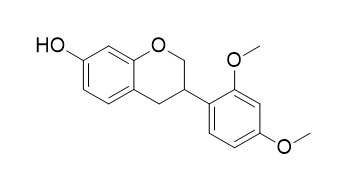Sativan
Sativan possesses a broad spectrum of antimicrobial activity against bacteria and phytopathogenic fungi, it exhibits antituberculosis activity against Mycobacterium tuberculosis H37Rv, with the MIC value of 50 ug/mL.
Inquire / Order:
manager@chemfaces.com
Technical Inquiries:
service@chemfaces.com
Tel:
+86-27-84237783
Fax:
+86-27-84254680
Address:
1 Building, No. 83, CheCheng Rd., Wuhan Economic and Technological Development Zone, Wuhan, Hubei 430056, PRC
Providing storage is as stated on the product vial and the vial is kept tightly sealed, the product can be stored for up to
24 months(2-8C).
Wherever possible, you should prepare and use solutions on the same day. However, if you need to make up stock solutions in advance, we recommend that you store the solution as aliquots in tightly sealed vials at -20C. Generally, these will be useable for up to two weeks. Before use, and prior to opening the vial we recommend that you allow your product to equilibrate to room temperature for at least 1 hour.
Need more advice on solubility, usage and handling? Please email to: service@chemfaces.com
The packaging of the product may have turned upside down during transportation, resulting in the natural compounds adhering to the neck or cap of the vial. take the vial out of its packaging and gently shake to let the compounds fall to the bottom of the vial. for liquid products, centrifuge at 200-500 RPM to gather the liquid at the bottom of the vial. try to avoid loss or contamination during handling.
Foods.2024, 13(19):3092.
Research Square2024, rs-4398438
Molecules.2021, 26(8):2161.
Korean J. Medicinal Crop Sci.2023, 31(6):388-395.
Separations2023, 10(4),255.
Biol Pharm Bull.2021, 44(12):1891-1893.
Anal Biochem.2019, 569:10-15
Molecules.2024, 29(22):5261.
Sci Rep.2017, 7:40345
Int J Mol Sci.2024, 25(5):2799.
Related and Featured Products
Pharmaceuticals (Basel). 2012 Aug 23;5(8):882-9.
The Chemical Components of Sesbania grandiflora Root and Their Antituberculosis Activity.[Pubmed:
24280680 ]
METHODS AND RESULTS:
Three isoflavanoids, isovestitol (1), medicarpin (2), and Sativan (3), along with another known compound, betulinic acid (4), were isolated from the root of Sesbania grandiflora. The structures of the isolated compounds were characterised by means of spectroscopic techniques (UV, IR, MS, 1H- and 13C-NMR, DEPT, COSY, HMQC, HMBC, and MS analysis).
CONCLUSIONS:
All the tested compounds 1-4 exhibited antituberculosis activity against Mycobacterium tuberculosis H37Rv, with MIC values of 50 µg/mL for compounds 1-3, and 100 µg/mL for compound 4, whereas, the methanol extract exhibited antituberculosis activity of 625 µg/mL. This is the first report on the occurrence of isoflavonoids in this plant and their antituberculosis activity.
Antimicrob Agents Chemother. 1980 Feb;17(2):120-3.
Susceptibility of zoopathogenic fungi to phytoalexins.[Pubmed:
7387136 ]
Phytoalexins are a group of low-molecular-weight antibiotics produced by higher plants in response to infection by relatively avirulent microorganisms.
They are of relatively low toxicity for mammalian cells and have been reported to possess a broad spectrum of antimicrobial activity against bacteria and phytopathogenic fungi.
METHODS AND RESULTS:
Employing a broth dilution technique, we have found the zoopathogens Petriellidium boydii, Aspergillus flavus, A. fumigatus, Candida albicans, Coccidioides immitis, Cryptococcus neoformans, Histoplasma capsulatum, Rhizopus oryzae, Sporothrix schenckii, and Trichophyton rubrum to be inhibited by one or more of the phytoalexins maackiain, medicarpin, phaseollin, phaseollin isoflavan, pisatin, Sativan, and vestitol in concentrations of from 12.5 to 50 microgram/ml. Phaseollin isofalvan was the most effective of these.
CONCLUSIONS:
In agar cup diffusion tests growth of the yeast form of Blastomyces dermatitidis was inhibited by phaseollin at 50 microgram/ml and by phaseollin isoflavan at 25 microgram/ml. Susceptibility of the mycelial form of B. dermatitidis to these two compounds was demonstrated by inhibition of radial extension on agar plates.



